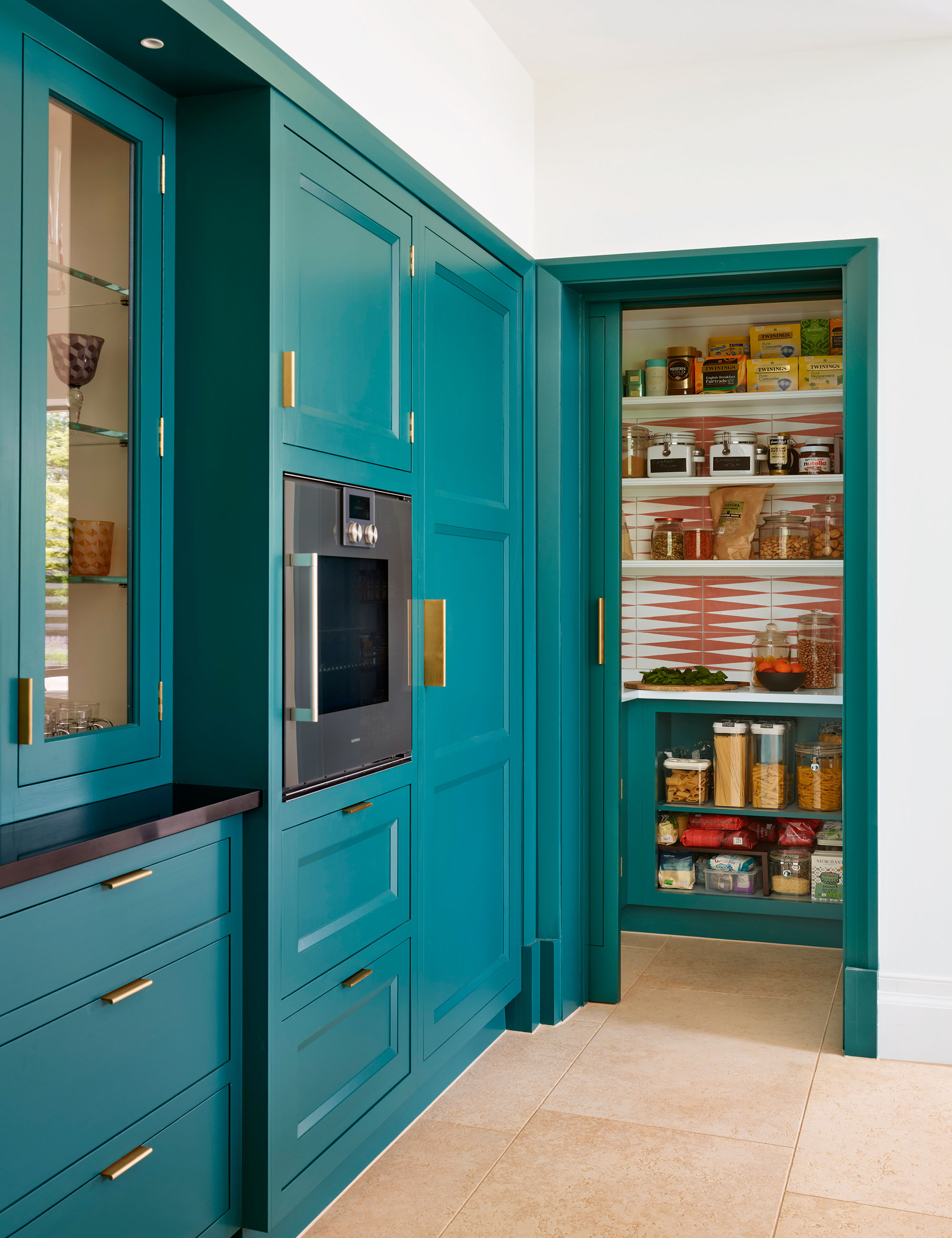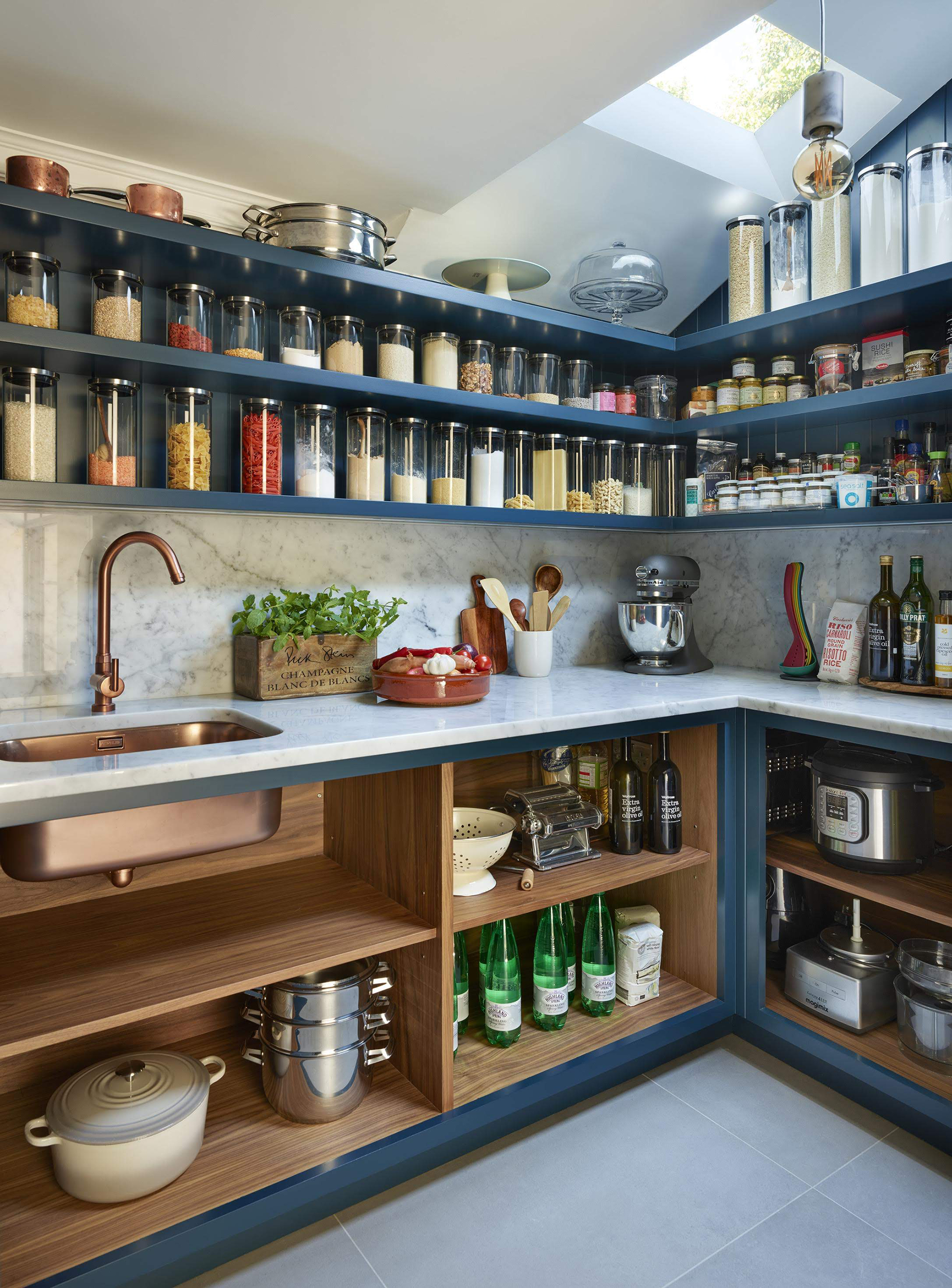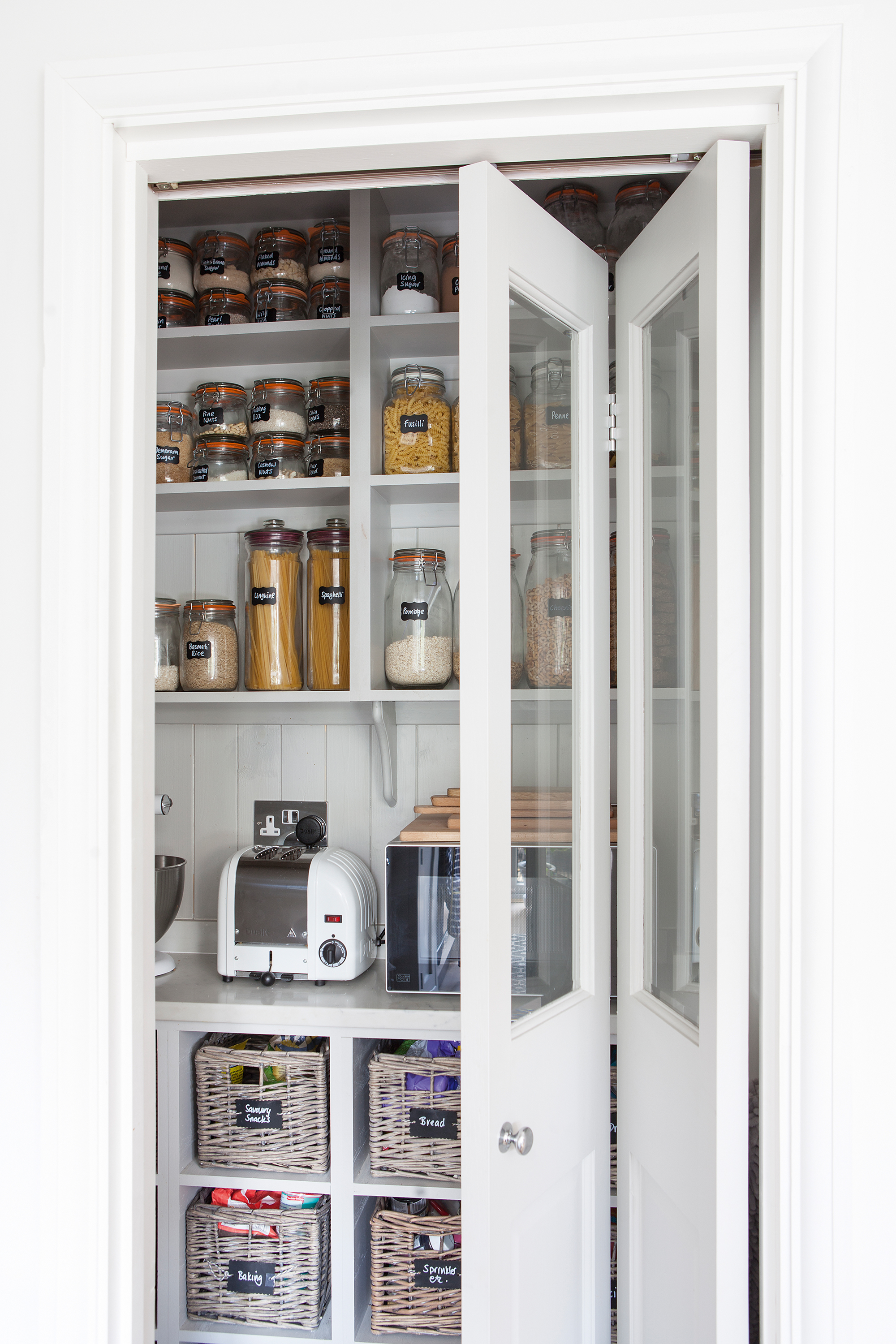How to organize a narrow pantry – 9 ways to make space for staples
Make meal prep a breeze (not a squeeze) with these top tips for organizing a narrow pantry

- 1. Start with a goal in mind
- 2. Choose open shelving for a narrow walk-in pantry
- 3. Decant pantry staples into slimline containers
- 4. Group similar food items together…
- 5. …and corral them into pull-out bins
- 6. Introduce storage helpers
- 7. Utilize the back of a door
- 8. Bear sell-by dates in mind
- 9. Avoid overstocking
- FAQs
There’s no doubt about it, organizing a narrow pantry can be frustrating. When you’re feeling the squeeze, take comfort in knowing that even the smallest, most awkward of spaces can still prove practical. As any pro will tell you, when it comes to organizing a pantry, size (and shape) doesn’t matter – it’s what you do with it that counts.
We all dream of beautiful walk-in pantry ideas with shelves aplenty, but the most successful pantry ideas are those that make best use of the space they have. Luckily, narrow pantries do lend themselves to some rather useful pantry storage ideas, which, when organized properly, can have a profound effect on the way you use your kitchen, and look equally as insta-worthy, too.
Whether it’s a walk-in or a pull-out larder cupboard, we’ve compiled our favorite ways to organize a narrow pantry, bearing both functionality and style in mind.
How to organize a narrow pantry
When organizing a kitchen in general, but particularly when organizing a small pantry, it’s important you start by taking stock of what you have and decluttering where necessary. Making room for pantry staples that you don’t want or need is an unnecessary waste of space, and likely a waste of food – those use-by dates come around quicker than you think!

1. Start with a goal in mind
These days, pantries are used to hold more than just food – appliances, serveware, table linens, even kettles, coffee machines and toasters can reside inside. Before you start trying to cram everything in however, bear in mind that narrow pantries have their limitations. If you want to make the space work for you, you’ll need to think logistically – and realistically – about how you want it to contribute to your kitchen layout overall.
'You may dream of clutter-free countertops, but if you’ve got a walk-in pantry with a narrow gangway, positioning working appliances doesn’t make sense – you simply won’t have enough room to use them safely. Rather than give up on the idea altogether, rethink how to make the pantry space you do have work for you. Using it for surplus supplies and lesser-used appliances might free up enough space in your kitchen to allow for the addition of a hidden breakfast bar, for example,' explains Jennifer Ebert, editor at Homes & Gardens online.

Jen is the Deputy Editor (Digital) of Homes & Gardens online. Before starting this position, she had completed various interior design courses at KLC Design School, as well as working across Ideal Home, LivingEtc, 25 Beautiful Homes and Country Homes & Interiors as an interiors writer.
2. Choose open shelving for a narrow walk-in pantry

Pulling out drawers and opening doors can be tricky – sometimes impossible – in narrow pantries. Instead, opt for easy-access kitchen shelving ideas. The ideal space between shelves is 40-50cm, but if you’re organizing a small space, shelves the height of just one glass jar can still be useful – position these higher up so you can see everything at a glance.
Design expertise in your inbox – from inspiring decorating ideas and beautiful celebrity homes to practical gardening advice and shopping round-ups.
If you have the width, deeper shelves should be positioned at the bottom and reserved for heavier, more bulky items. In a pantry cupboard, consider adding bespoke shelving (or adjusting existing ones) to maximize space in a similar way.
3. Decant pantry staples into slimline containers

As well as making for Instagram-worthy shelves, decanting dried goods into matching containers means you’ll be able to fit more into a narrow pantry. Choose designs of a uniform size and shape (ideally from the same brand), so they sit neatly side by side, or stack on top of each other, depending on how much vertical space you have available.
Clear glass jars make it easy to see when you’re running low, but it’s worth labeling as well so you don’t get your plain flour confused with your self-raising, your cinnamon with your cumin, and so on. Add the best-before dates so you can keep track of what you need to buy and when.
4. Group similar food items together…
Grouping like-items together can help keep a narrow pantry neat and tidy, and makes it easier to find ingredients quickly. How you categorize is up to you, but the easiest way is by standard food groups; tinned tomatoes, beans and pulses; pasta and rice, flour, sugar and baking powder, and so on.
5. …and corral them into pull-out bins
Avoid placing items directly onto surfaces – they’ll only get jumbled and likely pushed to the back. Instead, group them by category into baskets and bins. These perform the same function as drawers but have the added benefit of being able to pull right out, so you can then set them down on a counter and have a proper rifle through.
‘Opt for transparent storage with strong handles, like these stackable bins from Target, and always bear what you’re storing in mind. Taller items such as oils, dressings and sauces will need a container with higher sides so they don’t fall over, while heavier items might need a container with a reinforced base, for example,' says Millie Hurst, Solved section editor, Homes & Gardens.
Be sure to measure the height and width of the shelf before deciding on pull out storage. You ideally want a snug fit, so you’re not left with dead space at the back.

Millie Hurst is Section Editor at Homes & Gardens, overseeing the Solved section, which provides readers with practical advice for their homes. Millie has written about and tried out countless cleaning and DIY hacks in the six years since she became a journalist, and has worked in both London and New York.
6. Introduce storage helpers
Employing pantry organizers is the best way to maximize every inch of space in a narrow pantry. Some are more helpful than others depending on what you want to store. Lazy Susans are a space-saving way of storing jars, tins and bottles on existing shelving, while undershelf baskets create extra storage space for snacks, folded linens and small kitchen essentials. You could even install a slim rack for wine storage.
When organizing deep pantry shelves, Stephanie Nix, kitchen designer at Neptune advises using tiered storage. ‘Tinned food can be placed on a shelf to the back atop risers to allow you to see what you have without digging through several layers of cans, and clear containers are really helpful to easily spot what you need without rummaging,' she says.
7. Utilize the back of a door

If narrow shelf space is limiting your options, the back of a door has the potential to make up for it. Going bespoke allows you to tailor storage to exact needs, but store-bought racks and rails work just as well. Customizable versions, such as this door system from The Container Store are the most versatile (also handy if you're wondering where to store spices in a small kitchen).
If there’s not enough width between the shelving and the door, consider mounting flat hooks and using them to store shopping bags and aprons, perhaps even a string bag of vegetables if space allows. This is a great kitchen cupboard storage idea in general, actually.
8. Bear sell-by dates in mind
When replacing food items, put those newly bought towards the back of the shelf so you use up anything with less shelf life first. Do a regular stock take to avoid food sitting at the back unused. If your shelves are narrow and shallow, consider employing a similar organization system with risers; the item on top of the riser is the one to use up first with an extra stored underneath, for example.
‘Even if you’re not decanting into jars, removing bulky outer packaging is still worth doing to save some space. Be sure to cut out the product name, nutritional facts and expiration date and tape it to the packet or container, so you’ve still got all the information you need,' says professional organiser Laura Price, founder of The Home Organisation.
9. Avoid overstocking

Without the luxury of plentiful pantry storage, you’ll need to be cautious about how much you’re bringing home from the store going forward if you want to avoid clutter from building.
‘It’s great to save money on those things you use often, but if you don’t have the space to store them, the kitchen quickly becomes unmanageable. Having a really good understanding of the amount of things you can physically fit in your pantry is key to keeping it in shape going forward,' says Laura.
If space allows, consider mounting a blackboard either inside or next to your pantry, so you can keep an up-to-date list of what you need.
FAQs
How do you store pantry items in a small kitchen?
Not all of us have the luxury of a dedicated pantry, particularly if organizing a small kitchen. However, organizing a kitchen without a pantry is a lot easier than you might think – there’s plenty of ways you can create pantry-style storage without compromising on floor space. With the right pantry organizers, a kitchen cabinet can be just as effective at storing tins, jars and dried goods, similarly a deep drawer, if you have one.
Open shelving can play host to stylish food canisters, cook books and crockery, while hooks, rails and racks are great for hanging utensils, tea towels and aprons, freeing up space in cabinets for less aesthetically-pleasing items.
If you have the budget for bespoke, look around for unused alcove ideas that could be transformed into useful storage, the slim space next to the fridge or oven for example. You could also consider incorporating pull-down shelving underneath cabinets for organizing spices, or customize corner cabinets with pull-out versions.
So, as you can see, organizing a narrow pantry is not that much different to your more ‘regular’ versions. The secret to success is, as always, good planning. Think sensible storage systems and regular maintenance, plus a few savvy helpers thrown in to ensure every inch is put to best use!

For 10 years, Tara King worked as a Content Editor in the magazine industry, before leaving to become freelance, covering interior design, wellbeing, craft and homemaking. As well as writing for Ideal Home, Style at Home, Country Homes & Interiors, Tara’s keen eye for styling combined with a passion for creating a happy – and functional – family home has led to a series of organization and cleaning features for H&G.



